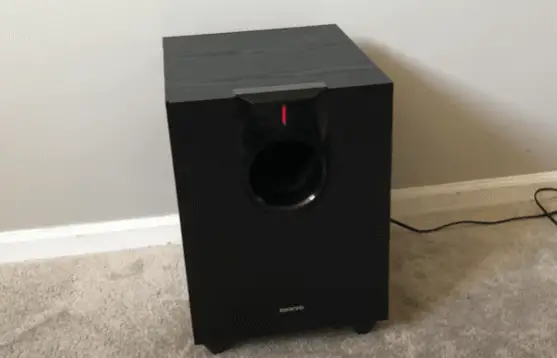Onkyo subwoofer not working mainly because of a faulty AC outlet, the subwoofer’s corroded power cable, a blown fuse, a change in menus setting, speaker size setting, disabled subwoofer, and the receiver’s incorrect setting.
Any of the above culprits could be responsible for stopping your subwoofer’s smooth running. But the challenging task is finding out the main cause and their perfect solutions.
Just go through each of our article’s points, and apparently, you will learn to detect and fix your subwoofer’s issue.
Table of Contents
Onkyo Subwoofer Not Working [7 Easy Solutions]
This troubleshooting guide contains all the reasons that stop your Onkyo subwoofer’s operating process and its effective solutions. Let’s start:
Note: You can also read how to fix the Onkyo receiver not displaying on TV.
1. Defective AC Outlet
The subwoofer’s power cord plugged into a faulty AC outlet is one of the significant reasons why your Onkyo subwoofer stopped working. The malfunctioning AC outlet fails to supply adequate power to the subwoofer.
As a result, it can’t function properly. However, the AC outlet can stop working for the following reasons:
- Bad electrical connection
- Tripped circuit breaker/ GFCI
- Sparking/ worn-out or damaged outlet
Solution:
Before plugging the subwoofer power cord into the outlet, first, verify whether the AC outlet is active or not. If you find the outlet is not working, go with the following solutions:
- Fix the faulty electrical outlet and connections
- Repair or replace the circuit breaker and tripping GFCI
- Replace the damaged outlet
2. Subwoofer’s Damaged Power Cable
The defective power cable can’t connect the subwoofer with its receiver correctly. The subwoofer will produce no sound if the wire becomes damaged while running to the receivers, amplifiers, or speakers.
However, the probable reasons behind this issue are:
- Cable sheath’s degradation
- Overheating cable
- Mechanical failure
- UV exposure
- Electrical overloading
- Rodent attack
- Insulation damage
- Loss of continuity
- Aging or reduced service life
Solution:
To solve the above issue, go with the following solutions:
- The cable’s sheathing materials degrade or crack over time thus, and you need to replace it
- Replace the damaged, overheated, and aged cable
- Avoid running too many appliances in one electrical outlet to avoid overheating
3. Blown Fuse
One of the main parts of the subwoofer is its fuse. The defective or blown fuse is another primary reason for which your Onkyo subwoofer pre-out not working. The causes of the blown fuse are:
- Over a long period continuously, the fuse sustained the highest volume
- The amp’s component failure
- Use of amplifier in under or over voltage
- Power-ups and downs cause the surge in the subwoofer
- Short in amp’s output section
Solution:
If the subwoofer’s blown fuse is the culprit, you should replace it immediately. The other solutions are the following:
- Avoid sustaining the subwoofer on maximum volume for a long time
- Inspect the amp’s failed component and replace it
- At under or over voltage, don’t use the amplifier
- Use high-quality power cables to ensure voltage stability
- Don’t use the subwoofer during the power’s up and down to avoid the power surge
4. Changed System and Menu Setting
If the defective AC outlet, blown fuse, or faulty power cable is not responsible for stopping working your Onkyo subwoofer, you should check the menu and system’s settings.
Accidental change in any setting can stop your Onkyo subwoofer’s working. Again adjusting the subwoofer’s output also hinders its easy operating process.
Solution:
Properly check the menu setting. Inspect whether the subwoofer is correctly connected with the audio input selections or not.
If you find it’s not connected or any other change in the menu setting, adjust the change correctly. Again ensure that the subwoofer’s output adjustment is not down.
5. Speaker Size Setting
The subwoofer fails to receive the signal properly because of the large speaker setting. However, sometimes some receivers may allow the subwoofers to produce sound and operate even with the speaker’s high setting.
But this could cause stop of the subwoofer’s work at any time.
Solution:
Avoid selecting the largest speaker size setting for your subwoofer. If the input device of your subwoofer offers you to change the setting, at first, you should select the lowest option.
Set the speaker size at this option, and your subwoofer will ideally receive the signal. Inspect the AV receiver menu and ensure every speaker is set to low.
However, you can follow the subwoofer manual to know the speaker size setting’s additional details.
6. Disabled Subwoofer In the Setting
If the subwoofer is disabled in the setting, it will not work. When the speaker’s pattern in the set ends in 0, the subwoofer fails to receive the signal. As a result, it produces no sound.
Solution:
Check the setting and enable the subwoofer. Follow the steps are:
- Select setting
- Go to the speaker
- Then, select Speaker SP
- Confirm the 1 or 2 is the ending pattern of the speaker
- Finally, your subwoofer will enable in the setting
7. Receiver’s Incorrect Setting
Incorrect receiver setup is another reason why your Onkyo subwoofer fails to produce audio output. When the whole system or front speakers are set to “Large,” then the subwoofer stops working.
This is because, instead of the subwoofer, the front speakers receive the low-frequency content when the speakers are set to “Full Range” or “Large.”
Solution:
To solve the above issue, within the receiver settings, activate or enable the subwoofer channel. Then in the receiver, set the “Whole System” or “Front Speakers” at “Small.” Setting small will ensure that the subwoofer will receive higher frequency content.
FAQs:
Why is my subwoofer not receiving the low-frequency effect?
The subwoofer may fail to receive the low-frequency effect because the audio source fails to send a signal to the subwoofer, presence of LFE signal, illumination of LEF indicator light, the sound field setting is not set to AFD, the speaker vibrates itself, etc.
Do I need an LFE input for a subwoofer?
Yes, you need an LFE input for your subwoofer if you want your receiver to receive the appropriate sound from the subwoofer. Having an LFE input for the subwoofer ensures effective audio production.
Why is my subwoofer on the left?
It doesn’t matter whether your subwoofer is left or right on the screen. Because it doesn’t reflect the original position of your subwoofer. Providing the subwoofer position’s demo is the only purpose of showing the onscreen graphic presentation.
Why do subwoofers sound better through the bottom of the speakers?
The speaker’s kick drums or amplifiers generate a straightforward direct pressure wave. As a result, the subwoofers sound better through the speaker’s bottom. Human ears can’t absorb downward sound waves; instead, the floor absorbs it most. Downward waves worsen the sound quality.
How much difference is there between different subwoofers?
There is no significant difference in sound-producing quality between the different subwoofers. If you run even the different subwoofers on the same wattage, it will produce the sound alike. Price can be the only difference between various subwoofers.
Conclusion
Hopefully, now why your Onkyo subwoofer not working is clear to you. If your subwoofer suddenly stops working, from now on, you will be capable of detecting the reasons behind the malfunction and solving it by yourself.
Still, if you are struggling to fix your Onkyo subwoofer’s issue, don’t hesitate to let us know your trouble in the comment box. We will definitely help you with the solutions.


About Gonzalez
William Gonzalez is a passionate researcher & electronics expert who is dedicated to solve complex electronic issues. Plus, he has a passion for sharing his knowledge & expertise in this field with others. Well, he breaks down the complex technical concepts into simple terms & shares them with his readers so that they can easily troubleshoot the problems with their electronic products as well as save their pockets.